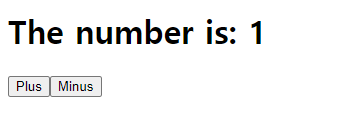[React.js] state와 Life-Cycle
state란?
state는 동적(dynamic) 데이터와 함께 작업할 때 만들어진다. 변하는 데이터, 존재하지 않는 데이터 생겨나고 사라지는 또는 변경된 데이터, 하나인 데이터 그리고 두개가 되고 또 0이 되는 그런 종류의 데이터
- state는 object이다.
- Component의 data를 넣을 공간이 있고, 이 data는 동적이다.
class Component란?
class Component
- render method 사용 가능
- class이지만 React Component로부터 확장되고 screen에 표시된다. 이는 render method 안에 포함되어야 한다.
- React는 자동적으로 모든 class Component의 render method를 실행하고자 한다.
- class Component를 사용하는 이유는 일반적으로 state 때문이다.
선언 방식
class App extends React.Component {
state = {
count: 0,
};
add = () => {
this.setState((current) => ({ count: current.count + 1 }));
};
minus = () => {
this.setState({ count: this.state.count - 1 });
};
render() {
return (
<div>
<h1>The number is: {this.state.count}</h1>
<button onClick={this.add}>Plus</button>
<button onClick={this.minus}>Minus</button>
</div>
);
}
}
extends React.Component는 React Class의 자식 클래스임을 의미한다.
그로 하여금 React 클래스에 사용된 여러 메서드를 사용할 수 있게 된다.
state를 변경시키는 방법
state를 변경하기 위해서는 setState() 메서드를 사용해야 함.
-
setState()를 사용하지 않으면 새 state와 함께 render function이 호출되지 않음 -
setState()를 호출할 때 마다 React는 새로운 state와 함께 render function을 호출함
import React from "react";
import PropTypes from "prop-types";
class App extends React.Component {
state = {
count: 0,
};
add = () => {
this.setState(current => ({ count: current.count + 1 }));
};
minus = () => {
this.setState({ count: this.state.count - 1 });
};
render() {
return (
<div>
<h1>The number is: {this.state.count}</h1>
<button onClick={this.add}>Plus</button>
<button onClick={this.minus}>Minus</button>
</div>
);
}
위와 같이 state를 선언하고
state = {
count: 0,
};
count를 변화시키는 함수를 선언한다. 이 때 사용하는 함수는 javascript이다.
minus 함수에 사용되는 문법은 사용 가능하지만 권장되지 않는다. add 함수에 사용되는 것과 같이 state를 직접 호출하지 않는 것이 외부 환경에 영향을 받지 않으므로 바람직하다.
add = () => {
this.setState((current) => ({ count: current.count + 1 }));
};
minus = () => {
this.setState({ count: this.state.count - 1 });
};
render method에서 this.state.count로 <h1> 태그 내에 count를 불러오고, 각 Plus와 Minus 버튼에 onClick props로 add 함수와 minus 함수를 이벤트 추가한다.
render() {
return (
<div>
<h1>The number is: {this.state.count}</h1>
<button onClick={this.add}>Plus</button>
<button onClick={this.minus}>Minus</button>
</div>
);
}
실행결과


위와 같이 Plus 버튼을 누르면 count가 증가하여 실시간으로 화면에 rendering 되는 것을 확인할 수 있다.
이 때, 개발자 도구에서 Elements를 확인하면 오로지 count 부분만 변경되는 것을 확인할 수 있다.

이것은 React 프레임워크가 Virtual DOM을 사용하기 때문이며 React의 강점이다.
Life Cycle Method
- 기본적으로 React가 Component를 생성하는, 또는 없애는 방법
-
Component가 생성 될 때, render 전에 호출되는 function이 있음
-
Component가 render 된 후, 호출되는 function이 있음
-
Component가 update될 때, 호출되는 function이 있음
mounting
- Component가 생성되는 것
constructor(): javascript에서 class를 만들 때 호출되는 것. (생성자)- Component가 mount될 때, screen에 표시될 때, Component가 Website에 갈 때, constructor를 호출함
사용예시1
constructor(props) {
super(props);
console.log("hello");
}
사용예시2
componentDidMount() {
console.log("Component rendered");
}
updating
- Component가 update되는 것
- setState를 호출하면, Component를 호출하고, 먼저 render를 호출한 다음 업데이트가 완료되었다고 말하면 componentDidUpdate가 실행됨
사용예시
componentDidUpdate() {
console.log("I just updated");
}
unmounting
- Component가 삭제되는 것
- 페이지가 바뀌거나 state를 사용해서 Component를 교체하는 것
- 페이지를 통째로 새로 불러오거나, Component가 삭제될 때
componentWillUnmount()가 실행됨
전체적인 사용 시점 확인
import React from "react";
import PropTypes from "prop-types";
class App extends React.Component {
constructor(props) {
super(props);
console.log("hello");
}
state = {
count: 0,
};
add = () => {
this.setState((current) => ({ count: current.count + 1 }));
};
minus = () => {
this.setState((current) => ({ count: current.count - 1 }));
};
componentDidMount() {
console.log("Component rendered"); // Component가 생성될 때 실행됨
}
componentDidUpdate() {
console.log("I just updated"); // Component가 update될 때 실행됨
}
componentWillUnmount() {
console.log("Goodbye, cruel world"); // Component가 삭제될 때 실행
}
render() {
console.log("I am rendering"); // render될 때 마다 1회 실행됨
return (
<div>
<h1>The number is: {this.state.count}</h1>
<button onClick={this.add}>Plus</button>
<button onClick={this.minus}>Minus</button>
</div>
);
}
}
export default App;
초기화면

위와 같이 초기화면에서는
constructor()에서 Hello 출력render()에서 I am rendering 출력componentDidMount()에서 Component rendered 출력
순으로 동작하는 것을 확인할 수 있다. 이중에 1, 3번은 본 예제에서는 Component가 생성되는 과정이 1회 뿐이라 1번만 동작한다.
버튼으로 count 변경시


기존 console에서 2줄이 추가된 것을 확인할 수 있다.
render()에서 I am rendering 출력componentDidUpdate()에서 I just updated 출력
Component의 state를 update할 때 즉각적으로 반영되는 것이 변경을 감지하여 render하기 때문임을 확인할 수 있다.
본 예제에서는 Component를 삭제하는 기능이 없어 ` componentWillUnmount() 동작을 확인할 수 없지만, Component 삭제시에 componentWillUnmount()`도 정상적으로 동작한다.

댓글남기기